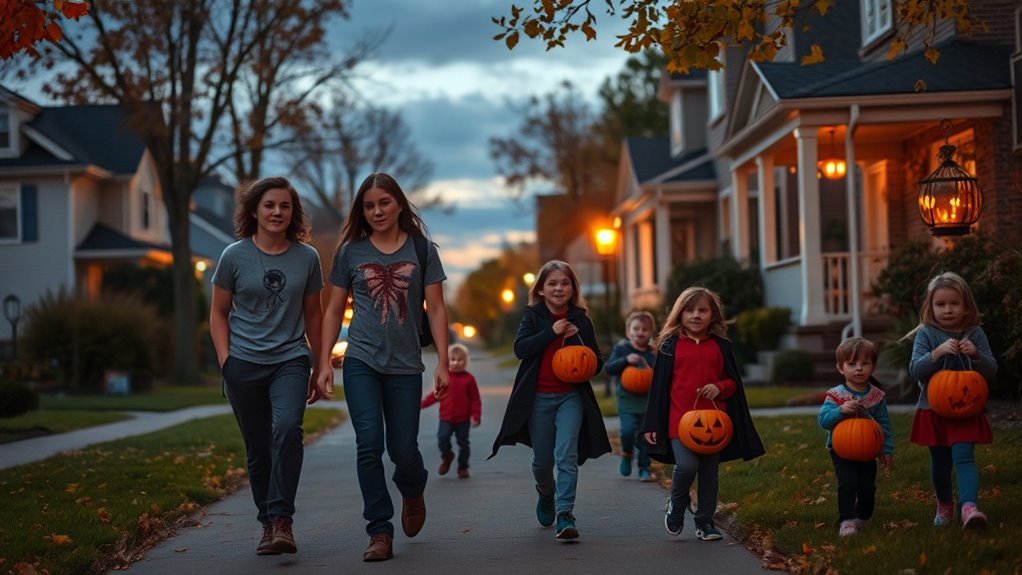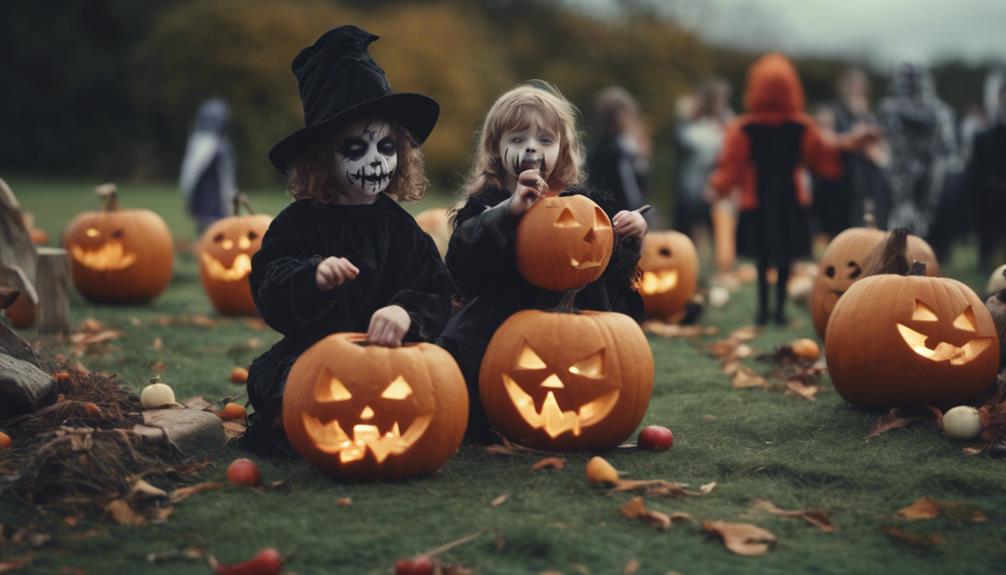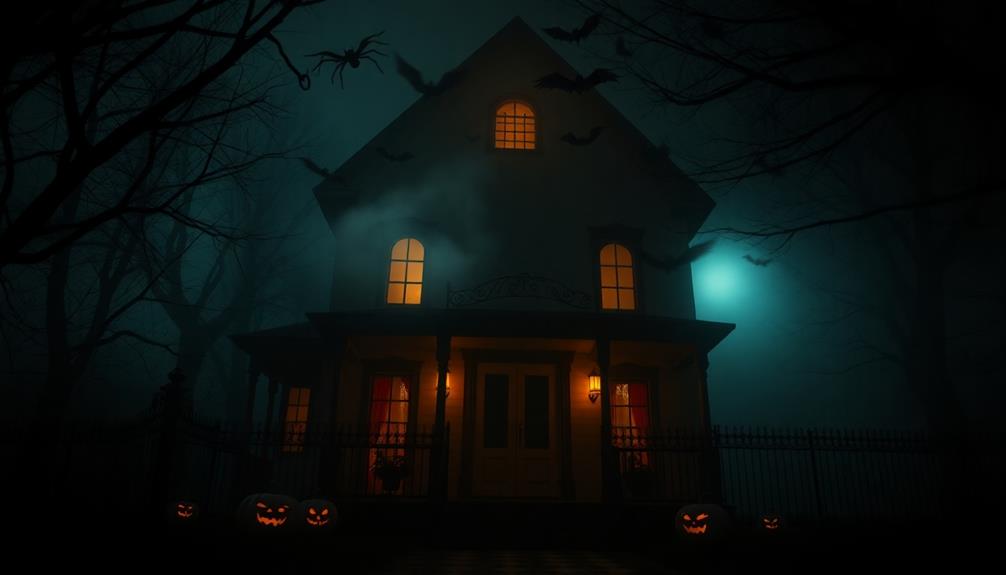Many communities set age limits for trick-or-treating to keep everyone safe, fair, and comfortable. These rules help prevent older kids from dominating the fun or causing trouble late at night. While some teens feel restricted, communities often offer special events or guidelines to include everyone safely. If you want to learn more about how communities balance fun and safety during Halloween, there’s plenty to think about regarding these debates and solutions.
Key Takeaways
- Communities set age limits to ensure safety and fairness, often restricting older teens from trick-or-treating.
- Debates focus on balancing teen participation with community safety concerns and the risk of mischief.
- Some neighborhoods organize special events or designated hours to include older children safely.
- Many communities encourage teens to follow guidelines, participate respectfully, and engage in supervised activities.
- The discussion aims to promote inclusive, enjoyable Halloween experiences while maintaining safety for all ages.

Many communities set age limits for trick-or-treating to guarantee safety and fairness during Halloween. These rules often aim to create an environment where younger children can enjoy the holiday without feeling overwhelmed or overshadowed by older kids. As a teenager, you might find yourself questioning these limits, especially when you see your friends dressing up in the latest teen costume trends. You want to participate fully in the festivities, but at the same time, you understand that communities are trying to balance fun with safety concerns.
Neighborhood safety is a primary reason behind these age restrictions. Larger groups of older kids can sometimes behave unpredictably, increasing the risk of accidents or mischief. Communities worry about traffic hazards as teens might be less cautious while rushing from house to house or hanging out in groups that could be intimidating for younger children. By setting age limits, they hope to reduce these risks and make the night more enjoyable and secure for everyone.
As a teen, you might feel that these rules unfairly target you or limit your freedom to celebrate. However, understanding the reasoning behind them can help you see the bigger picture. Many neighborhood safety measures also include curfews and designated times for trick-or-treating, which aim to prevent late-night disturbances and ensure all residents feel comfortable. You can still find ways to participate within these boundaries—dress up in cool, trendy costumes that align with current teen costume trends, and stick to neighborhoods that welcome older kids. Some communities even organize special events or designated hours for teens, allowing you to enjoy Halloween without feeling out of place.
If you feel the age limits are too restrictive, consider collaborating with your community or local organizers to suggest safe, inclusive ways for teenagers to trick-or-treat. You might propose organized teen events or costume contests, which can provide a safe outlet for your enthusiasm and creativity. Remember, these rules aren’t meant to exclude you but to foster a safer environment for everyone. Participating in community-led activities can help you still enjoy the holiday while respecting safety guidelines. Embracing the spirit of Halloween within the guidelines can still make the night memorable—whether it’s through your creative costume, your friendly neighborhood interactions, or participating in community-led activities.
Ultimately, understanding and respecting these age limits can help you enjoy Halloween responsibly, without risking safety or fairness. It’s about finding a balance—having fun, expressing yourself through your costume trends, and respecting community efforts to keep everyone safe. When everyone works together, Halloween can be a festive, secure night for all ages.
Frequently Asked Questions
How Do Communities Enforce Age Restrictions During Trick-Or-Treating?
You might wonder how communities enforce age restrictions during trick-or-treating. Often, they rely on community patrols or volunteers to monitor the event and guarantee kids follow guidelines. Enforcement challenges arise because it’s difficult to identify age accurately and manage large crowds. Some communities post signs or set specific hours, but ultimately, it’s about balancing safety and fun while keeping an eye out for teens who might be too old for trick-or-treating.
Are There Any Safety Concerns Associated With Older Teens Trick-Or-Treating?
Imagine a Halloween night where shadows stretch longer and costumes grow bolder. You might worry about teen safety, as older kids could unintentionally become targets or cause vandalism concerns. While most teens mean no harm, the risk of accidents or mischief can cast a dark cloud over the festivities. Staying vigilant helps protect everyone, ensuring that the spooky night remains fun and safe for all ages.
What Alternative Activities Are Available for Teens During Halloween?
You can explore fun alternatives like costume contests or haunted house events instead of traditional trick-or-treating. These activities let you enjoy Halloween safely, showcase your creativity, and get into the spooky spirit. Many communities host themed parties and interactive experiences perfect for teens. Participating in these events keeps you engaged, safe, and social, making Halloween memorable without needing to go door-to-door for candy.
How Do Parents Typically Respond to Community Age Limit Policies?
Imagine a community debating trick-or-treat age limits. You’ll find that parental objections often stem from concerns about safety and tradition. Many parents react passionately, urging for more inclusive policies or alternative activities for teens. Community reactions vary—some embrace the changes, while others resist, fearing it’ll diminish Halloween spirit. As a result, you might see a mix of support and opposition, shaping how policies evolve and how teens participate.
Have Age Limit Policies Impacted Local Community Spirit or Participation?
You might notice that age limit policies influence community engagement and neighborhood traditions. When teens are restricted, some residents feel less connected, and the festive spirit declines. Conversely, others see it as a way to preserve safety and tradition. Overall, these policies can either strengthen or weaken participation, depending on how well communities communicate their intentions and involve all age groups in celebrating together.
Conclusion
As communities consider new guidelines, remember it’s all about finding a gentle balance that respects tradition while embracing change. Encouraging older kids to enjoy the festivities in a respectful way helps everyone feel included and safe. By softly adjusting the expectations, you help foster a spirit of fun and understanding. In the end, it’s about creating a welcoming environment where everyone can share in the joy of the season, no matter their age.









